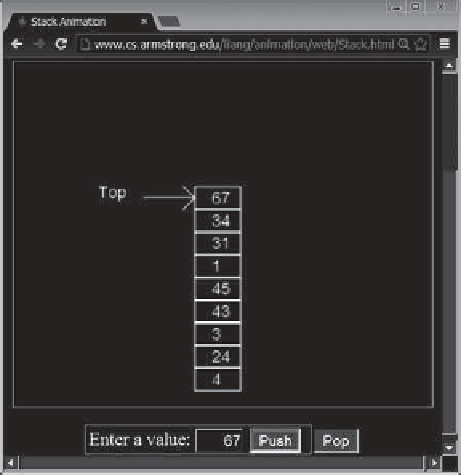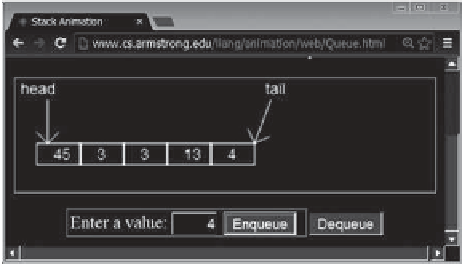Java Reference
In-Depth Information
Pedagogical Note
For an interactive demo on how stacks and queues work, go to
www.cs.armstrong.edu/
shown in Figure 24.20.
stack and queue animation on
Companion Website
(a) Stack animation
(b) Queue animation
F
IGURE
24.20
The animation tool enables you to see how stacks and queues work.
Since the insertion and deletion operations on a stack are made only at the end of the stack,
it is more efficient to implement a stack with an array list than a linked list. Since deletions are
made at the beginning of the list, it is more efficient to implement a queue using a linked list
than an array list. This section implements a stack class using an array list and a queue class
using a linked list.
There are two ways to design the stack and queue classes:
Using inheritance: You can define a stack class by extending
ArrayList
, and a
queue class by extending
LinkedList
, as shown in Figure 24.21a.
■
inheritance
Using composition: You can define an array list as a data field in the stack class, and
a linked list as a data field in the queue class, as shown in Figure 24.21b.
composition
■
ArrayList
GenericStack
LinkedList
GenericQueue
(a) Using inheritance
GenericStack
ArrayList
GenericQueue
LinkedList
(b) Using composition
F
IGURE
24.21
GenericStack
and
GenericQueue
may be implemented using inheritance
or composition.
Both designs are fine, but using composition is better because it enables you to define a com-
pletely new stack class and queue class without inheriting the unnecessary and inappropriate
methods from the array list and linked list. The implementation of the stack class using the com-
position approach was given in Listing 19.1, GenericStack.java. Listing 24.7 implements the
GenericQueue
class using the composition approach. Figure 24.22 shows the UML of the class.















































Search WWH ::

Custom Search